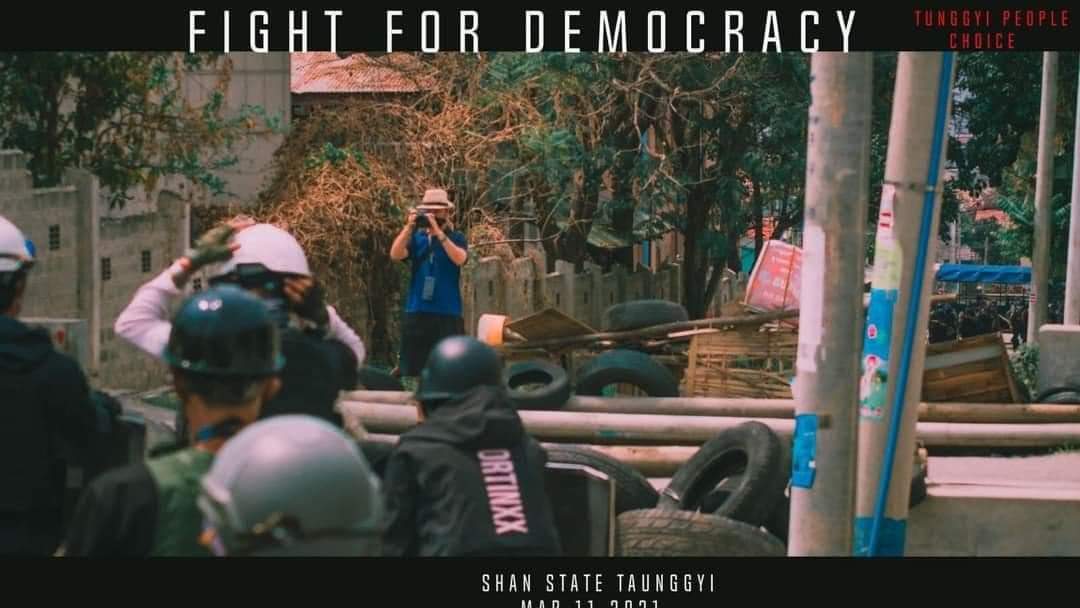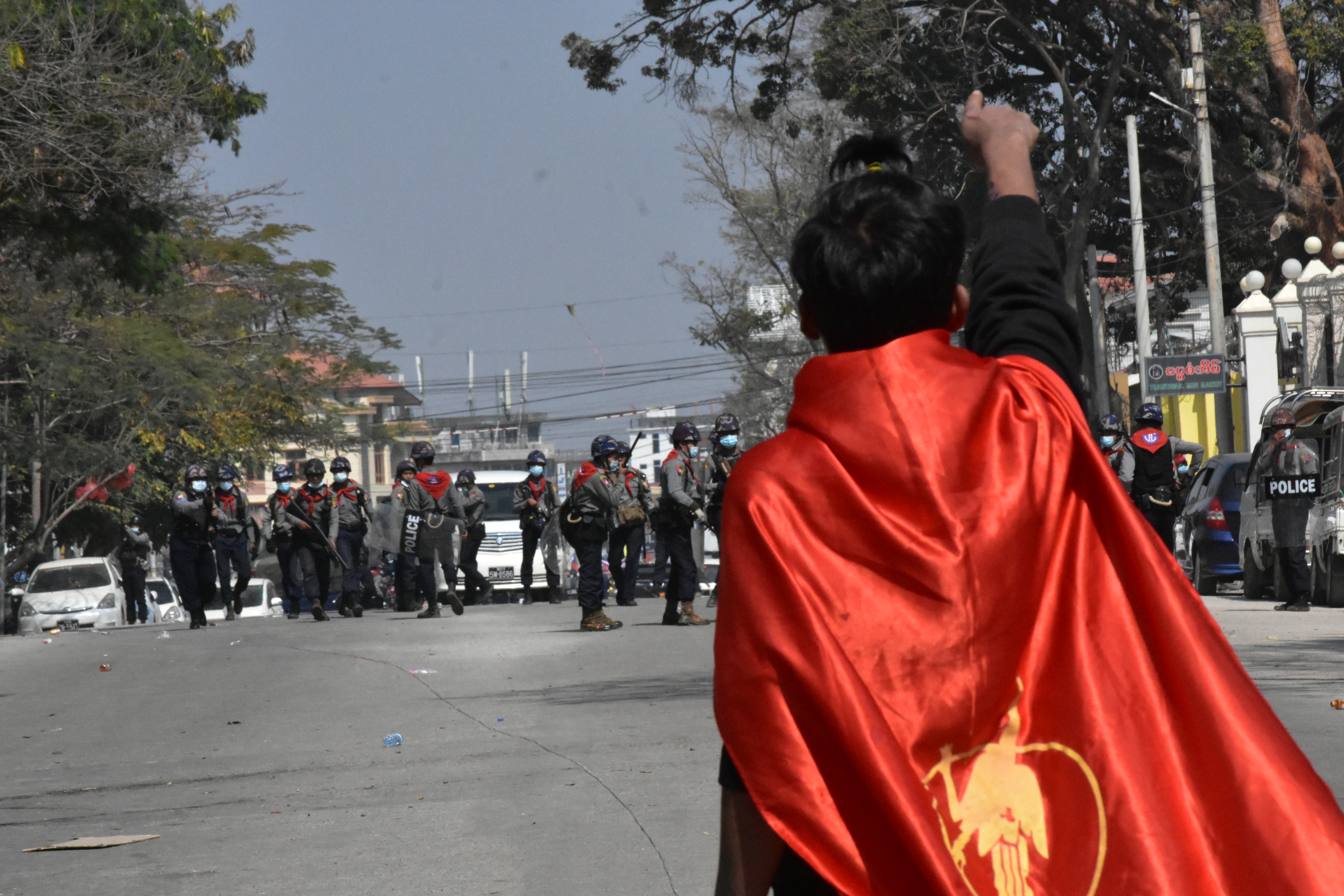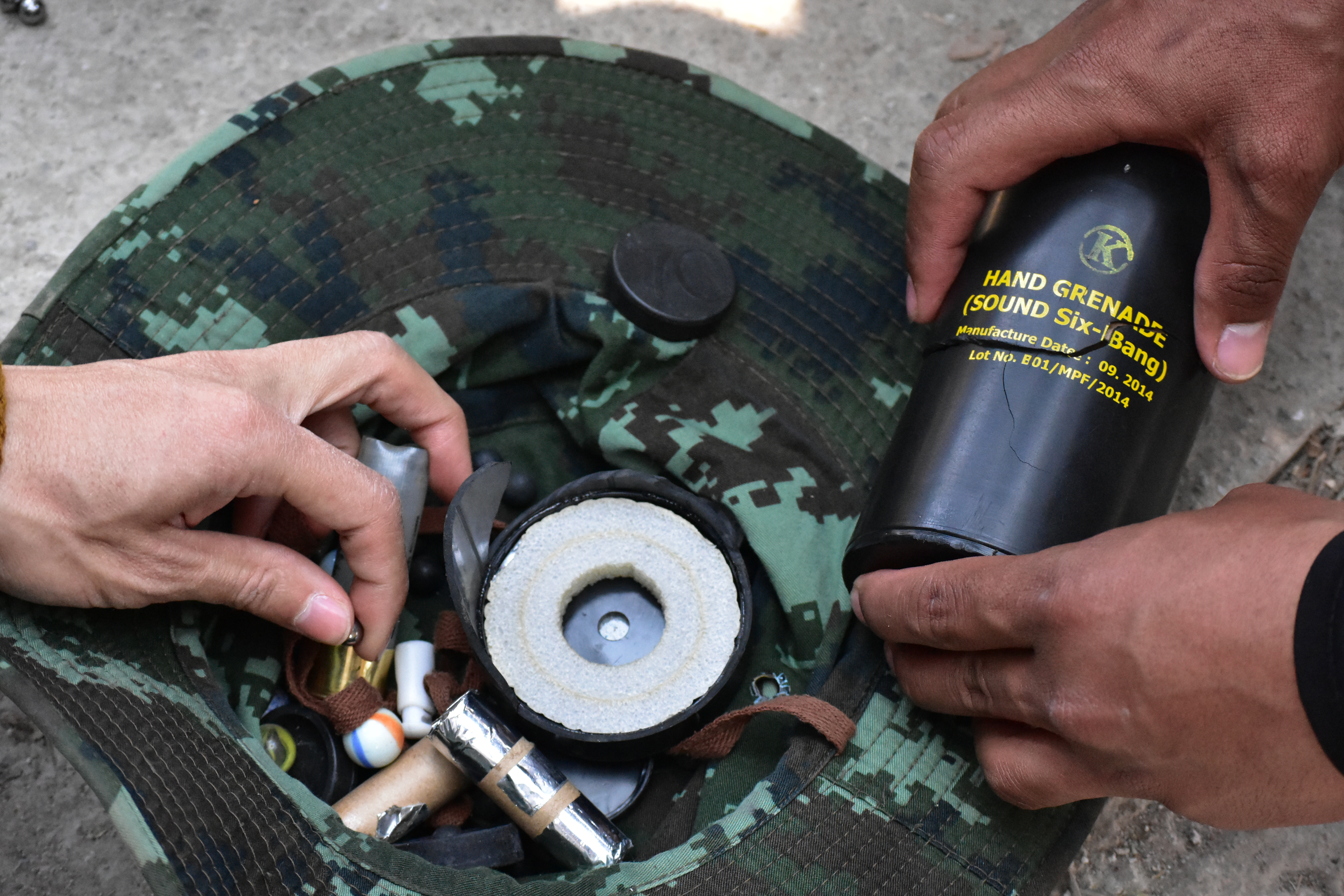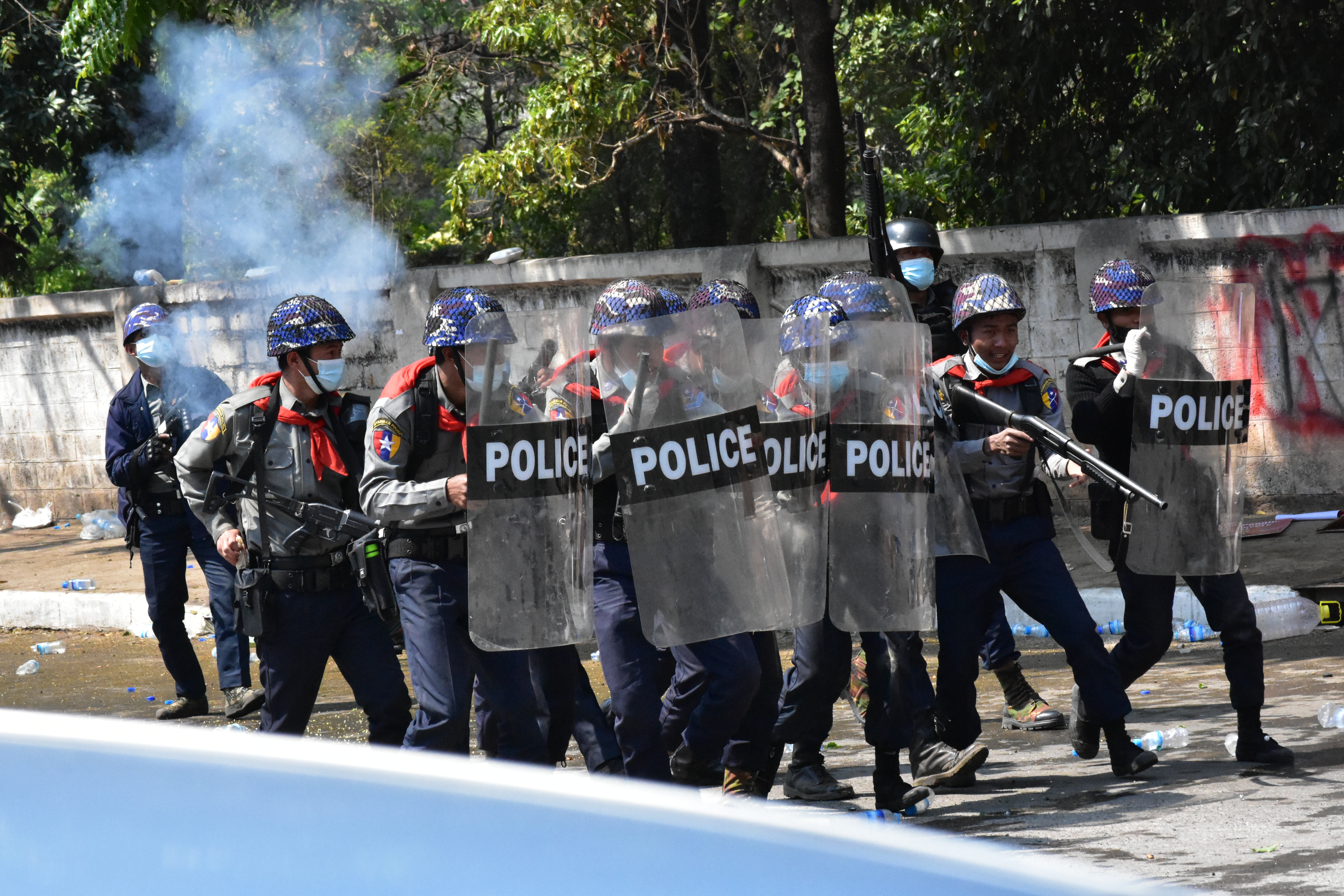Reporting on the current developments in crisis-torn Myanmar has become increasingly insecure and unpredictable.
When Yuki Kitazumi, a Japanese journalist based in Yangon, was arrested on February 26 while covering a protest, many observers held their breath. After five or six hours of detention at a police station in the city’s Sanchaung township, the first detained foreign journalist was finally released, but “without [his] camera’s memory card.”
“They checked all my documents, and explained that they did not notice that I am a foreign journalist,” Kitazumi told me over Facebook Messenger.
The fact that his detention did not last long reassured me at the time that non-Myanmar nationals were not bring targeted explicitly by the security forces, which seemingly preferred to avoid a backlash from the international community.
Throughout February and early March I attended dozens of protests, which took many forms.
Honestly, it was hard to escape the reality of Myanmar turning into one large protest site when demonstrators were passing in front of my guesthouse, sometimes waking me up with their chant of revolutionary songs.
Being based in southern Shan State in the town of Nyaungshwe at Inle Lake, I felt that I was a bit too far away from the core of anti-coup demonstrations, which in my view was the major cities of Yangon, Mandalay, and Naypyidaw.
But thanks to social media, which the military failed to block effectively, the protesters in farther flung areas were able to observe the techniques, strategies, and inventions from Myanmar’s main cities, and deploy it in their smaller protests. At the same time, the protesters in my area became very creative in mounting new forms of protests.
In this way, I documented the now-famous demonstrations on boats staged on the country’s iconic Inle Lake, where hundreds of members of the Intha ethnic community displayed their anti-coup slogans on the surface of water. Dressed up in traditional attire, they did not face any security forces patrolling them; those events cheered the protesters, uniting various ethnic groups in one movement.
At the time, there was little violence in this corner of Myanmar. Both children and adults were dressing themselves in colorful traditional outfits and carrying slogans demanding the restoration of democracy. Some have even decided to tattoo their own bodies with the face of detained leader Aung San Suu Kyi, while donating to the Civil Disobedience Movement, the movement of government workers who followed the advice of their ousted leader not to work for the dictatorship.
On a number of occasions I went to the capital of Shan State, Taunggyi, which was only 45 minutes away from Nyaungshwe, to document protests in much larger numbers. Every morning, the members of different ethnic groups marched proudly through the main street of the city. They sang the protest anthem “We Shall Not Surrender Till The End of the World,” while almost brushing the gate of the police station and the office of the military-aligned Union and Solidarity Development Party. Back then, the security forces only watched the people from the side of the road, not reacting to protesters flashing the three finger salute in their direction.
That suddenly changed on February 28, the Milk Tea Alliance Day. After around an hour of marching protest in Taunggyi, before my eyes, the ocean of colorful placards vaporized in a matter of seconds when loud motorbikes sped through the crowds. Then tear gas was thrown into the mass of demonstrators, only for a clear line of soldiers and policemen to emerge on the horizon from behind the cloud of gas. The security forces were coming forward to disperse the protesters, who were shocked but not intimidated enough to end the demonstration. They moved to another street.
On that and subsequent days I always believed that I should stay close to them, and continue monitoring what was exactly happening: what weapons both sides used, and how protesters defended themselves. I considered the risk low, as in contrast to other places in the country, there were no casualties in Taunggyi at that time.
On March 11, I again arrived in Taunggyi, bypassing the road blockade set up by the military, to interview the members of the Civil Disobedience Movement. It was not an easy task given that all these people were in hiding; scared of being detained, they could not sleep at their own houses. After talking to some of my contacts to gain their trust, I asked to be shown where a protest was about to start at midday. Because the armed forces were still forcibly dispersing the protesters, the protests did not take place on the main road like before, but in the smaller streets on the hills of the town.
Nothing foreshadowed a bad turn of events for me. Many times I found myself in a close proximity to soldiers and policemen, and the worst reaction I got was to hear them telling me to stay away.
The protesters were always glad that a foreign journalist was at the event, as they wanted their voice to be heard abroad. People also approached me many times, declaring that they “want the U.S. and U.N. to intervene militarily.”
In the matter of a few minutes, however, I became the subject of news, instead of reporting on this peaceful protest being dispersed.
Tear gas was shot into the group of protesters. They ran away, but I stubbornly remained with my camera in hand, standing some 10 meters away in a side street. Feeling too confident, I did not attempt to hide. Then, out of blue around, 10 soldiers surrounded me, two or three of them hitting my arm and head with plastic batons. Too shocked to think anything, I protected myself and my camera with my right arm until two policemen intervened by pulling the soldiers away.
The explanation I heard later in the Immigration Office was that my face mask had disguised my identity. They also decided that they must investigate whether I was working without authorization as a journalist.
“I can’t do anything when the immigration officer requests a two-week arrest,” a judge told me the next day. She was distressed to see my bruises but she could not do more.
Maybe I should have been happy that I could see a lawyer so fast. Myanmar’s most prominent detainee, Aung San Suu Kyi, was allowed a meeting with her representative only after two months of house arrest.

An image of Robert Bociaga, a few minutes before his assault and arrest, shared broadly on Facebook.
I knew that as a foreigner I would always be treated better by the authorities. My time in detention was without any forms of abuse. I shared a big cell with seven Myanmar inmates, all of us denied contact to the outside world.
There was one thing that cheered me up every night: The noise from protesters banging pots and pans outside was heard even inside my cell. Ironically, it took an arrest for me to understand the importance of this form of protest.
For all these days I tried to stay positive, although I could not know if my case was moving forward in a desirable direction. I joked to myself: Why is the government media mouthpiece called “The Global New Light of Myanmar“? Because in detention, the light is always on. Day and night.
Fortunately, the German Embassy, which represented me, was effective in putting pressure on the authorities. On March 22, earlier than originally scheduled, I pled guilty in front of the judge to breaching my visa (while the charge of unauthorized journalism disappeared). It was announced that I would be free upon paying the penalty of $130.
I was transported back to the police station where all my belongings remained, where I had an opportunity to talk to the policemen and learned their views on the political situation. Obviously, I did not want to push too hard, in order to not raise suspicions.
“The protesters turned into terrorists; they burn police posts and car tires.”, a young policeman from a military family told me. “People do not understand what we are doing for them. They love Aung San Suu Kyi no matter what although she’s charged [with] falsifying the elections and bribery.”
He added that he had no sympathy for protesters being shot dead, saying they were warned that the army has a right to use deadly force. I left him a bit confused, having said that in other countries the army does not play such a role in politics.
But not every policeman expressed his love for the military so firmly. Short conversations with other policemen speaking just a few words of English revealed that this group is indeed divided – something that many Myanmar people had suggested to me in the past.
After another night at the police station, I was summoned for a phone call with the German ambassador to arrange my plane ticket out of the country. While walking quite freely around the police station, I peered into an open room and saw a young man kneeling, hands folded behind his head, giving testimony under duress. Was it one of the protesters? I did not dare to ask.
Later I found out that during my arrest, at least five people died in Taunggyi, one of them in another police station.
“I [still] see red blood, as they killed some people in front of me,” wrote one of the protesters to me later via Messenger.
Early on the morning of Wednesday, March 24, I was taken by car from Taunggyi to Yangon, accompanied by three immigration officers. While our car shook its way along the bumpy highway, rushing to arrive as soon as possible, one of them joyfully exclaimed several times during this 10-hour trip that “this highway is very good and it was built by General Than Shwe, not Aung San Suu Kyi.”
Roger that.
As the handcuffs remained in the car, I decided to not discuss other achievements of the military government – a long list of human rights violations, which seemingly not everyone was familiar with.
“We know democracy is a way forward. The army will hold elections in a year or so,” the same immigration officer added with conviction during a break at a tea shop.
“Can I take a photo?” I humorously responded. He had told me many times that if I did not take any photos, I would not have any problems.
He chuckled.
Later, in silence broken only by the officer cackling at protesters chanting the revolutionary songs, we arrived in Yangon where I could stay in one of the hotels, of course accompanied by immigration officers.
I was finally allowed to fly out of Myanmar the next day, on March 25, and regained access to my phone and camera, including the original memory cards. But I knew that hundreds of other people remained imprisoned and had no chance to leave the country, although many might wish to do so. Many accounts report abuse, particularly in Yangon’s infamous Insein Prison, where detainees live in jammed cells, without access to a lawyer.
In this whole situation, I should consider myself to be very lucky, my lawyer told me later. I was not arrested in a city where major protests were being held; that could explain why neither my phone nor my internet presence were really investigated.
During my detention, I lost two weeks of time in which I could not report on the developments in Myanmar. But chasing after the best shot in the increasingly hostile environment where a stray bullet can hit anyone is not the definitive aim of a photojournalist. Maybe the arrest saved my life.
Dozens if not hundreds of citizen journalists have reported on a wide range of crimes committed by Myanmar’s security forces. Their reports stirred some words of condemnation from the international community and some governments imposed sanctions, which turned out to have many loopholes.
The number of local journalists being arrested and media outlets having their licenses revoked is rising day by day. Combined with the internet restrictions imposed by the military, this effectively means that the information flow out of Myanmar is heavily dammed, blocking the world from knowing about developments as they happen.
Meanwhile, Myanmar military newspapers do not sleep. They continue enforcing among the trusted elite the view that dangerous protesters are destabilizing the country. One of the photos that has started circulating shows protesters carrying toddlers on their backs at night. Depending on which side of the conflict a viewer is on, they might denounce the image as fabricated or consider it to be the gospel truth.
Journalism is dying in Myanmar, while the whole country is on the verge of civil war.
Against that backdrop, the fact that Clarissa Ward, a CNN journalist, was suddenly allowed into the country at the end of March stirred mixed feelings among Myanmar people. The fact that such a visit could not happen without the consent of the military led many people doubt that the station would be allowed to report freely. “Can she be trusted?” Many people reached out to me with this question.
When touring Yangon by car, Ward was welcomed by people banging pots to indicate they are still protesting. She did get the chance to speak to some of the high-level generals, which is rarely possible, but their responses were rather predictable. All the time, however, Ward was accompanied by military officers. After talking to a few people at one of the city’s markets, her interview subjects were arrested for instigating a protest.
When voicing dissent to military rule is considered instigation to protest, there is little space in today’s Myanmar to freely report about the events unfolding on the ground.




































